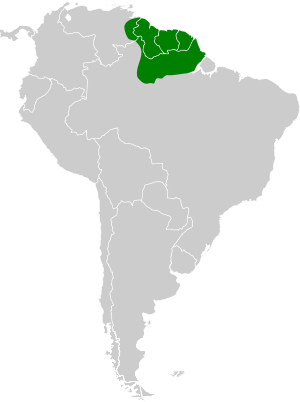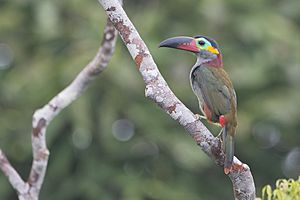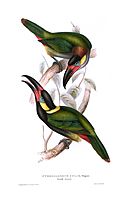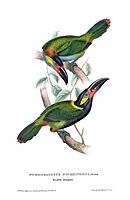Guianan toucanet facts for kids
Quick facts for kids Guianan toucanet |
|
|---|---|
 |
|
| A male Guianan toucanet at the Dallas World Aquarium, USA | |
| Conservation status | |
| Scientific classification | |
| Genus: |
Selenidera
|
| Species: |
piperivora
|
 |
|
| Synonyms | |
|
|
The Guianan toucanet, also known as the Guyana toucanet (Selenidera piperivora), is a colorful bird from the toucan family. It is found in several South American countries. These include Brazil, French Guiana, Guyana, Suriname, and Venezuela.
Contents
How It Got Its Name
The Guianan toucanet has had a few different scientific names over time. It was first described and named Ramphastos piperivorus. Later, it was called Selenidera culik. However, its current official scientific name is Selenidera piperivora. This bird is considered a "monotypic" species. This means it is the only type of bird in its specific group.
What It Looks Like
The Guianan toucanet is about 33 to 35 centimeters (13 to 14 inches) long. Males usually weigh between 129 and 159 grams (4.5 to 5.6 ounces). Females are a bit heavier, weighing from 132 to 165 grams (4.7 to 5.8 ounces).
Both male and female toucanets have a similar bill pattern. However, the female's bill is shorter. The bill has a yellowish line at its base. Most of the upper part of the bill (called the maxilla) and the lower part (the mandible) are black. But their bases are red. The red color extends further on the lower part of the bill.
Both sexes also have bare blue skin around their eyes. They have a small tuft of yellow feathers right behind this blue skin.
Males have black feathers on their head, neck, throat, chest, and belly. They have a golden "collar" on their upper back. The rest of their upper body is green. Their tail is green with chestnut-colored tips on the feathers. The feathers under their tail are red.
Adult females have a black cap on their head. Their neck and upper back are chestnut-colored, with just a hint of a yellow collar. Their underparts are gray to green-gray, and their belly is green-yellow.
Young toucanets look similar to adults. However, their colors are not as bright. Their feather patterns and bill colors are also less clear.
Where It Lives
The Guianan toucanet lives in a wide area of South America. You can find it from the very southeastern part of Venezuela. From there, its range goes east through the countries known as the Guianas. It also lives in northern Brazil and south to the Amazon River. Specifically, it lives between the Rio Negro and where the Amazon River meets the ocean in the state of Amapá.
This bird prefers moist forests. This includes "gallery forests," which are forests that grow along rivers in savannas. It likes old, untouched forests more than areas where trees have been cut down. It usually lives at elevations up to 600 meters (2,000 feet). But in Venezuela and Suriname, it can be found as high as 900 meters (3,000 feet).
Behavior
Movement
Scientists believe that the Guianan toucanet stays in the same area all year round. It does not migrate to other places.
Feeding Habits
The Guianan toucanet mostly eats fruit. It also eats insects. There is some evidence that it has a special relationship with the Oenocarpus bacaba palm tree. This means they might have evolved together. These birds usually look for food in pairs or small groups. They typically forage in the middle to upper parts of the forest.
Reproduction
The Guianan toucanet breeds at different times depending on the location. In Venezuela and the Guianas, they breed between March and May. In Brazil, their breeding season is from April to July. During courtship, male toucanets will feed the females.
They build their nests in holes made by woodpeckers. Sometimes, they even take over a hole from the woodpecker that made it! A female toucanet usually lays two or three eggs. In captivity, the eggs hatch in about 16 days. The time it takes for the young birds to leave the nest in the wild is not known.
Sounds and Calls
The Guianan toucanet makes many different sounds. However, it does not use them very often. Its song is a slow series of deep, frog-like "arrouk" notes. Its main call is a rattling sound, like "trrrr-trrrr-trrrr..." This is sometimes joined by a rising squawk that can sound like a rooster, "kaaaaaaiiiiii." It also makes various soft rattles and other calls. Some of these calls are used when they are being aggressive. Others are used during courtship feeding or at the nest.
In Captivity
The Guianan toucanet is sometimes kept by people. It can be kept as a breeding bird in aviaries or as a pet.
Conservation Status
The IUCN (International Union for Conservation of Nature) has assessed the Guianan toucanet. They have listed it as a species of "Least Concern." This means that the bird is not currently at risk of disappearing. It lives in a very large area. Even though its exact population size is not known, it is believed to be stable. No immediate threats to its survival have been found. It is considered common in many parts of its range.
Gallery
-
An illustration from 1834 by John Gould and Elizabeth Gould. The female is shown above, and the male below.
See also
 In Spanish: Tucaneta de la Guayana para niños
In Spanish: Tucaneta de la Guayana para niños






